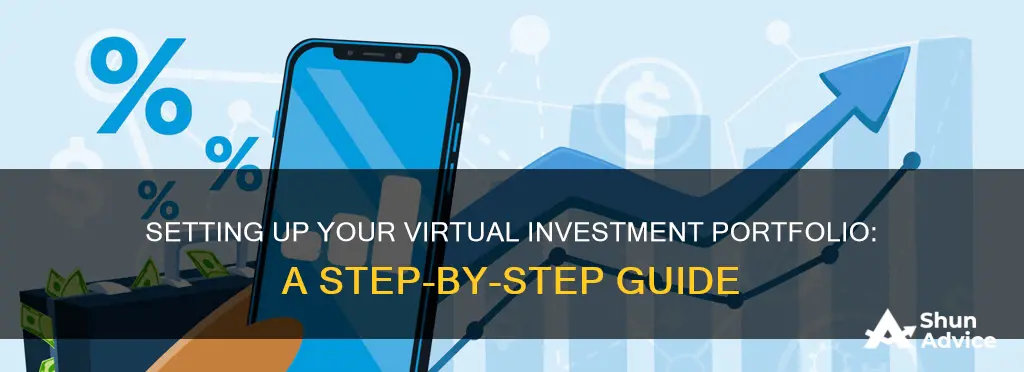
A virtual portfolio is a risk-free way to practice investing and build your confidence. It allows you to invest virtual money in a simulated portfolio to see the performance of stocks, ETFs, bonds, commodities, cash and cryptocurrencies over time. You can set up several different portfolios simultaneously and compare their performance. This helps you to understand the impacts of your strategy and gain experience without losing any real money.
| Characteristics | Values |
|---|---|
| Purpose | Learn about investing without the fear of losing money |
| Function | Simulated collection of financial investments |
| Investments | Stocks, bonds, commodities, cash, exchange-traded funds (ETFs), cryptocurrencies |
| Benefits | Risk-free, build confidence, test ideas, practice investing |
| Data insights | Starting dollar value, value today, total profit or loss, annual return, annual risk, Sharpe ratio |
| Platforms | Plynk, Financial Times, MockPortfolios.com, MarketWatch Virtual Stock Exchange, Wall Street Survivor, How the Market Works, MockCryptoGame.com |
| Cost | Free or low-cost |
| Target users | Aspiring investors, beginners, teens, professionals |
What You'll Learn

Choose a platform
There are several platforms that offer virtual portfolio services. These include free and paid options, each with its own unique features and capabilities. Here are some popular choices:
- Plynk App: This app allows you to create multiple virtual portfolios with a range of stocks and ETFs. It offers a simple, step-by-step process to set up your virtual portfolio and provides various metrics to help you analyse its performance.
- Financial Times (FT) Website: The FT portfolio tool is free and allows you to create virtual portfolios, track their performance, view relevant news, and compare them with indices like the FTSE 100 or S&P 500.
- MockPortfolios.com: Designed specifically for teen investors, this platform offers mock trading competitions with virtual cash and a range of stocks to choose from. It's a great way for young investors to get familiar with the stock market in a safe environment.
- MarketWatch Virtual Stock Exchange, Wall Street Survivor, and How the Market Works: These platforms provide similar features, allowing users to set up mock trading portfolios and compete with others to gain experience in the stock market.
- Ziggma: Ziggma is a comprehensive investment management platform that offers portfolio tracking and stock analysis tools. It helps investors understand their portfolios and make better decisions with its robust management and research capabilities.
- Delta Investment Tracker: Delta is a multi-asset portfolio tracker with a minimalist interface. It allows users to track live price movements of various asset classes, including cryptocurrencies, stocks, ETFs, bonds, options, and futures. Delta provides clear notifications and supports multiple devices, making it a great choice for beginners.
- AssetDash: AssetDash is ideal for investors with multiple assets, including NFTs and cryptocurrencies. It supports a wide range of apps and financial markets, allowing users to link their stock brokerage, crypto exchange addresses, and bank accounts. AssetDash also prioritises privacy, requiring only an email and password to sign up.
- Stock Rover: Stock Rover provides in-depth insights into your portfolio's performance, holdings, dividend-adjusted returns, and the risk and reward of investments. It offers easy-to-understand charts and analysis tools to help you make informed decisions.
- Kubera: Kubera is a modern financial tracker that helps users monitor their net worth and investment returns across various asset classes, including cryptocurrencies, stocks, ETFs, mutual funds, currencies, and more. It stands out for its connectivity to major crypto exchanges, wallets, and financial institutions worldwide. Kubera also offers intuitive charts and graphs for a comprehensive overview of your portfolio.
When choosing a platform, consider your specific needs and goals. Some platforms may offer more diverse asset options, while others might provide more educational resources or advanced analytics tools. Additionally, factors such as privacy, cost, and ease of use should be considered to ensure the platform aligns with your preferences and requirements.
Savings Investment: Choosing Wisely for Your Future
You may want to see also

Select assets
When selecting assets for your virtual portfolio, you can choose from a range of financial investments, such as stocks, bonds, commodities, cash, and exchange-traded funds (ETFs). You can also include cryptocurrencies in your virtual portfolio if you want to explore that asset class.
It's important to consider your investment objectives and time horizon when selecting assets. If you're investing for the long term, you may be able to include riskier assets in your portfolio, as you'll have more time to recover from any short-term losses.
Diversification is a key strategy to consider when selecting assets. By investing in a variety of asset classes, sectors, and markets, you can potentially reduce the risk of losing money. For example, if one sector or market is performing poorly, another may be performing well, which can balance out the overall portfolio.
When selecting individual stocks, it's important to research the companies thoroughly. Read news articles, annual reports, and other relevant information to understand the company's financial health and prospects.
You can also use financial ratios as a screening tool to identify potential investments. These ratios can help you compare companies and evaluate their financial performance and prospects.
Additionally, consider the risk profile of different assets and sectors. For example, energy companies often have volatile stocks with large swings in share prices, while stocks associated with food businesses tend to be more stable.
By carefully selecting a diverse range of assets and conducting thorough research, you can build a virtual portfolio that aligns with your investment goals and helps you gain experience and confidence in investing.
Savings Strategies: Where to Invest for Maximum Returns
You may want to see also

Diversify
Diversification is a crucial aspect of setting up a virtual investment portfolio. Here are some detailed instructions and considerations to help you diversify effectively:
Understand the Importance of Diversification
Diversification is often referred to as a "battle cry" for financial planners and investors alike. It is a risk management strategy that involves blending different types of investments within a single portfolio. The key idea is that by investing in a variety of assets, you increase your potential returns while reducing overall risk. Diversification ensures that your portfolio is not overly dependent on a single investment or market, so if one investment underperforms, others can offset those losses.
When building your virtual portfolio, consider various asset classes such as stocks, bonds, commodities, real estate investment trusts (REITs), and exchange-traded funds (ETFs). Diversifying across asset classes means that if stock prices fall, other types of investments, like bonds, which typically move in the opposite direction, can help stabilise your portfolio.
Think beyond your home market and invest globally. Diversifying across geographic regions and sectors can help reduce your risk and provide exposure to different economic conditions and industries. For example, you could invest in stocks from various countries, ensuring a mix of large-, mid-, and small-cap companies across industries like technology, healthcare, energy, and financials.
Consider Mutual Funds and ETFs
Mutual funds and ETFs are excellent tools for achieving diversification. These funds are professionally managed collections or "baskets" of individual stocks or bonds, allowing you to instantly gain exposure to a diverse range of investments. They are also cost-effective, as they often come with low fees, and they save you the time and resources required to research and manage individual investments.
Be Mindful of Over-Diversification
While diversification is essential, it is possible to over-diversify your portfolio. Over-diversification occurs when adding more investments increases overall risk and reduces expected returns. This can happen when you have too many overlapping holdings or when you include assets that are too closely correlated with each other. For example, investing in gold, silver, and platinum might seem like diversification, but since these metals tend to perform similarly, they may not offer the desired diversity.
Regularly Review and Rebalance Your Portfolio
Diversification is not a "set it and forget it" strategy. Markets fluctuate, and your asset allocation can drift over time. To maintain your desired level of diversification, review your portfolio regularly and rebalance by shifting investments to match your intended allocation. Financial advisors typically recommend reviewing your portfolio annually and rebalancing when an asset class deviates more than 5%-10% from its target allocation.
By following these guidelines and staying mindful of the potential pitfalls, you can effectively diversify your virtual investment portfolio, reducing risk and maximising the potential for long-term growth.
Savings or Investments: The Best Way to Utilize Your 100K
You may want to see also

Monitor performance
Once you've set up your virtual portfolio, it's important to monitor its performance to understand how your investments are doing and make any necessary adjustments. Here are some key steps to help you monitor the performance of your virtual investment portfolio:
- Track key metrics: When you view your virtual portfolio, you will have access to various metrics that will help you understand its performance. These typically include the starting dollar value, current value, total profit or loss, annual return, annual risk, and Sharpe ratio.
- Analyse individual investments: Drill down into the performance of each investment within your portfolio. Look at the latest price per share, the change in share price over time, and the profit or loss for each investment. This will help you identify which investments are performing well and which may need to be adjusted or replaced.
- Compare to benchmarks: Compare the performance of your virtual portfolio to relevant benchmarks such as the S&P 500 or the FTSE 100. This will give you a broader context for understanding how your investments are doing relative to the overall market or a specific index.
- Monitor real-time events: Keep an eye on how your virtual portfolio is impacted by real-time events such as central bank rate changes, political situations, and environmental issues. This will help you understand the sensitivity of your portfolio to external factors and make more informed investment decisions.
- Review performance regularly: Set aside time at regular intervals to review the performance of your virtual portfolio. This could be weekly, monthly, or quarterly, depending on your preferences and the level of activity in your portfolio. Regular reviews will help you stay on top of your investments and make any necessary adjustments.
- Utilise virtual portfolio tools: Take advantage of the tools and features offered by your virtual portfolio platform. For example, some platforms may offer alerts or notifications when certain conditions are met, allowing you to take prompt action if needed. Additionally, some platforms may provide advanced analytics or reporting features to help you gain deeper insights into your portfolio's performance.
By following these steps, you can effectively monitor the performance of your virtual investment portfolio and make more informed decisions about your investments. Remember, the whole point of a virtual portfolio is to simulate real-world investing, so treat it as if it were real money to get the most out of the experience.
Savings and Investments: Strategies for Success in Lean Times
You may want to see also

Compare to real-world markets
A virtual portfolio is a great way to get a feel for investing in the real world. It is a risk-free way of practising investing and finding out which strategies work for you. You can set up several different portfolios simultaneously and compare their performance over time.
However, it is important to remember that a virtual portfolio may not always accurately reflect real-world markets. For example, a virtual portfolio may not account for any fees you'll pay when investing in real estate, such as brokerage or trading fees. This means your virtual profits may be higher than in reality. Additionally, not all simulation platforms are the same, and some may be better than others at realistic simulation. In the real world, there are numerous factors that can affect financial markets, and some may be difficult to replicate virtually.
Despite these potential limitations, a virtual portfolio can still be a valuable tool for learning about investing and gaining confidence in your investment decisions. You can use a virtual portfolio to test different financial ratios and filters for choosing investments, and get a sense of how your investments might perform in the real world.
Overall, while there may be some differences between a virtual portfolio and real-world markets, a virtual portfolio can still be a useful tool for educating yourself about investing and making more informed investment decisions.
The Emotional Rewards of Saving and Investing
You may want to see also
Frequently asked questions
A virtual investment portfolio is a risk-free way to simulate investing in stocks, bonds, commodities, cash and exchange-traded funds (ETFs). It allows you to "invest" virtual money and observe the performance of your chosen stocks or ETFs over time.
Virtual investment portfolios are a great way to build confidence, especially if you're new to investing. They allow you to practice investing without the fear of losing real money. You can test different investment strategies and gain experience in a safe environment.
Setting up a virtual investment portfolio is straightforward. Several websites, such as Plynk, Financial Times, and MockPortfolios.com, offer this service for free. You can create an account, choose a name for your portfolio, select the stocks or other assets you want to invest in, and specify the virtual dollar amount you wish to invest.
It's important to consider your investment goals, time horizon, and risk tolerance. Diversification is also key—spread your virtual investments across different sectors, indices, and countries to minimize risk. Additionally, treat your virtual portfolio seriously and don't make investments you wouldn't make in real life, as this can skew your results.
There are several recommended tools available, including Ziggma, Delta Investment Tracker, AssetDash, Stock Rover, and Kubera. These platforms offer various features such as portfolio tracking, stock screening, and real-time market data to help you make informed investment decisions.







